Dell Dimension XPS: Gaming with all the Trimmings
by Wesley Fink on November 13, 2003 10:35 PM EST- Posted in
- Systems
Dell Dimension XPS: XPS Chassis
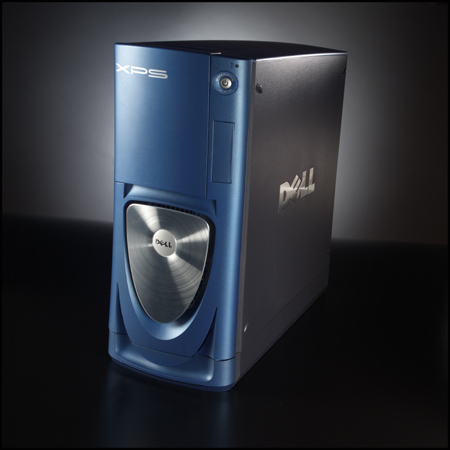
Dell's XPS chassis is a heavy-duty mid-tower finished predominately in blue with dark gray sides. The large 460-watt power supply is located at the bottom of the chassis with 2 small fans exhausting hot air to the rear from the power supply.
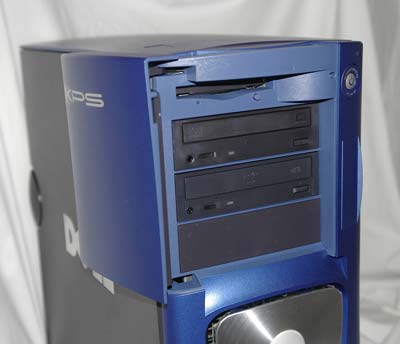
The floppy and 3 external drives bays are concealed behind a door. The door design is very clever and is hinged so that it can be stored conveniently on the side of the machine if you prefer constant access to the optical and floppy drives. Our test machine had both the latest 8X DVD+RW and a high-speed 48X CD-RW in black to match the system accessories.
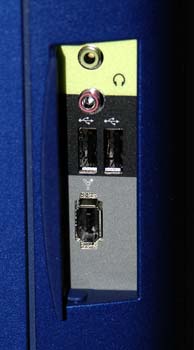
Inside a front slide-open door are the front jacks, which include 2 USB, firewire, and headphone jacks.

While the chassis is blue, Dell's theme on the peripherals is black or black with silver trim. This is carried though to the keyboard with volume control. A Logitech Optical scroll mouse, also a matching silver and black, was included with the test system.
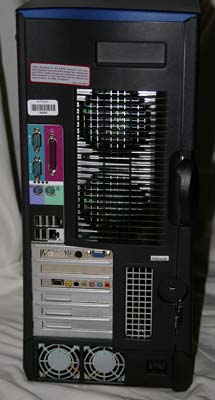
I doubt anyone could complain about the ports on the Dimension XPS rear panel. You get 6 more USB 2.0 jacks, the full complement of Audigy 2 audio I/O, digital and analog outputs on the ATI 9800 XT, 2 modem ports for those still using dial-up for the Internet, LAN port, parallel, 2 serial, and PS2 mouse/keyboard ports. There is not an old-style game port, but if you are buying a new gaming system, you are likely buying new USB game controllers as well. Through the slotted grill, you can see two large fans that exhaust hot air from the heat-duct that contains the CPU.

Getting into the Dell XPS case is as simple as pushing a large catch at the back of the left side. The entire left side and front of the chassis swings out to give you complete access to the motherboard, slots, and drive bays. This is certainly one of the slickest designs that we have seen in a case from any manufacturer.
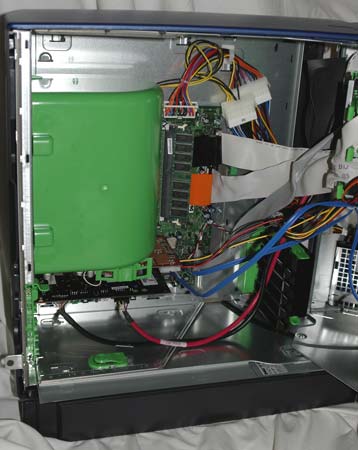
With the case open, you get a good view of the green cooling duct that covers the 3.2GHz CPU in our test machine. Hot air from the CPU is directed to the rear of the chassis by this duct and exhausted by two large fans. Most people who buy a gaming system really aren't particularly concerned about noise, which is why we did not measure Sound Levels in our evaluation. However, with all the fans that are active in the XPS, we found it to be a very quiet computer. We doubt that noise from the computer will be an irritation for XPS users.










43 Comments
View All Comments
araczynski - Friday, November 14, 2003 - link
this has got to be one of the most pointless reviews i've ever seen here.this site is for people that are more or less tech-savvy, who like to build their own machines. why would we care about the performance of a pre-packaged-just-add-water box from anybody (at least anybody mainstream). i think its a known fact that you'll never get your money's worth with those.
no, i didn't read the review, and based on teh comments above, i'm glad i didn't waste my time.
please get back to the more meaningfull stuff.
Wesley Fink - Friday, November 14, 2003 - link
#9 - AnandTech works very hard to maintain consistent conditions when we test COMPONENTS, but a system has to be viewed differently. If the system is a barebone it is tested with standard components, but if it is a complete system we do not modify it for testing by removing or changing components. We are not, in this case, testing just a motherboard, or just a drive system, we are testing a complete system as delivered to and used by end users. End users will not remove the Audigy for gaming, not will they replace the 9800 XT with a 9800 PRO to see how games run. We therefore test complete systems, as much as we can, as we receive them. This is particularly true with the Dell XPS, because the user is VERY unlikely to change anything in this machine.We were careful to point out differences from our other benchmarks so readers would not jump to the wrong conclusions. We did consider publishing these benchmarks in isolation, without comparisons, but that would tell you little about the Dell's performance compared to the best components we have tested.
Perhaps you will be more satisfied with the benchmark comparisons when we test a similarly equipped ElitePC system running an Athlon64 FX in an upcoming review.
jlv - Friday, November 14, 2003 - link
This review leaves me with a bad feeling.The XPS won on tests where hard drive speed mattered, and that's because it had a faster disk subsystem (striped SATA). Is that called out in the
"comments"?
Here you are holding up a $3300 system, and it doesn't outperform. (But you give us a "special offer" to buy one ourselves). I'd love to know what the other systems cost, for comparison sake.
Overall, this is the type of "review" that lead me to stop going to TomsHardware.
Possessed Freak - Friday, November 14, 2003 - link
This is probably the only review I have disliked from Anandtech for the past year or two.If you suspect the audigy is causing benches to slow down, and you can't fully disable the device in windows, remove it?
If you have a faster video card than all the other benches, change it?
Offer two bars for the tests, one "as shipped" and one "modified" so we can see if there is something else holding the dell back.
You suspect sata raid is speeding up some benches, as a reviewer isn't it your job to find out? I don't have one of these machines to see just how the raid affects the benches, you do. Run a myriad of tests to find out just why the dell is all over the place in these benchmarks.
If you are not willing to change the dell specs then how hard is it to add audigy's to the other test bed machines, or add the latest vid card?
LoneWolf15 - Friday, November 14, 2003 - link
Quoted from the article:"It is not designed for the hobbyist or overclocker; rather, it is designed and tweaked for the buyers who want their gaming system already set up, already tweaked for best performance, and ready to give great gaming performance right out of the box. As we evaluate the Dell Dimension XPS, this is an important distinction. Overclockers and tweakers will not be satisfied with the XPS"
Guess what? This means that probably 90% or better of Anandtech readers WILL NOT be satisfied with the XPS.
Even if I'm not overclocking, and not pushing my system's BIOS to the limits, I can build a system with similar components far cheaper, with better down-the-road upgradeability and at least equal performance and build quality. I can also do without the LCD --no matter how sleek they look, LCD's still aren't for gamers or video/graphics pros, IMHO.
Dell is fairly good in a business environment (I'm a sysadmin over several hundred of them) though support has gone downhill since they moved their phone centers from the US to Bangalore, India. I'd rather support myself, and I'd think most Anandtech readers would too. I just don't see this system as being targeted at the average Anandtech reader.
AlexWade - Friday, November 14, 2003 - link
Can I gripe about Dell's for a second?Our computer labs just upgraded to Dell's. I swear, they seem so slow. But, here is where my gripe with Dell begins. If I said the LCD has a bad image quality, I'd be giving it too much credit. I can see the individual dots with my face 1 foot away from the screen.
Okay, I'm done complaining.
firtol88 - Friday, November 14, 2003 - link
"Dell shipped the XPS with an ATI Radeon 9800 XT video card, which was used for all benchmarks with the Dell system. Please keep in mind that all of our comparison benchmarks were run with the ATI Radeon 9800 PRO, which is slightly slower."OK so this is really just an add right...
Anyway your conclusion should read 'when equiped with a vidieo card offering an 8% increase in clock speed, a 7% increase in memory speed and double the video memory this Dell XPS system can almost keep up with the other systems we tested...'
TrogdorJW - Friday, November 14, 2003 - link
I think the discrepancies that show up in the testing are very easy to pinpoint. But what a waste of good components. It would be SO easy for Dell to provide a truly great gaming system, but they are held back by their need to be proprietary and not allow any tweaking.First, the defects. As stated, lack of tweaking is not a good thing for most of us. Worse than that, though, is that the system will not even run at the SPD settings in memory modules. I can live without being able to manually set the timings, since this is Dell, but if I have CAS2 2-2-2-6 RAM, by DAMN the system had better run at those settings! That, incidentally, is almost certainly why the system performance drops so far in some tests.
Next, they go with an i875 chipset for the motherboard, but then they don't even give you Intel's Gigabit CSA interface. Is it needed? Not by a lot of people, but come ON, Dell - your in freaking bed with Intel already, so at least give us their top features! For a system targetted at gamers and costing a cool $3G, there's no reason to stick the user with an old 10/100 Ethernet connection.
Now, the case looks pretty cool, for the most part, but that is a butt-ugly cabling job. I realize that IDE cables are spec'ed to be no more than 18 inches long, but if you go with QUALITY cables, you can get longer 24" cables that work fine (especially since they're only for the CD drives), and there *has* to be a way to hide them out of the way a bit better. As much as it pains me to say this (since one of the few companies I hate more than Dell is Apple - I blame it on having to support Dell systems at my job), for a look at how to properly create a fold-open case and still keep the IDE cables tucked away nicely, the G4 systems were great. Again, Dell could have easily done the same, and they SHOULD have done the same for their XPS "Gamer" machine.
While I'm on the subject of the case, I understand that it is overall a pretty well-made system, but the huge cover over the CPU and motherboard just looks fugly if you ask me. Yeah, it works, but it sure ain't gonna win a beauty contest! Also, the 460W power supply is a nice addition. Too bad it's a proprietary Dell design, I'm sure, so if it goes out and your warranty is expired, you'll be spent ordering a replacement from Dell for $200 or so. (Unfortunately, this probably isn't exaggerating!) And WHY IN TARNATION DID THEY PUT THE POWER SUPPLY ON THE BOTTOM!? Oh, wait, there's no tweaking, so you don't need to worry about heat... but *still*, it's just odd. I mean, the PS creates a LOT of heat, heat rises.... Stupid.
Finally, did I mention that Dell systems are PROPRIETARY? It's not a big deal now, when you buy the system and it's all new and happy. But three or four years down the road, when parts start having issues and the warranty is gone, what are you going to do? I've seen proprietary Dell motherboards for old Pentium II systems that will still cost you over $200! And since the power supply, case, and motherboard are all proprietary as well, you're stuck either paying Dell a premium for service, or else you have to buy a new case, power supply, and motherboard should any of these fail after the warranty. DO NOT DISCOUNT THIS COST!!!
Now, with all of my complaints about that out of the way, let me address the benchmarks. Gee... scores seem to be all over the place. Wonder why? Well, my guess is that it's due to bottlenecks that the various benchmarks stress. Common bottlenecks include the memory subsystem (Quake 3 is notorious for stressing this!), hard drives, graphics card, and of course all of these at the same time, in varying degrees.
So it set a new high in Content Creation? No big surprise, since the benchmark is heavily influenced by hard drive speeds, and the striped SATA array is certainly up to snuff. Several of the other benchmarks depend on hard drive speeds to varying degrees, and when this is the case, the Dell gets a boost relative to the other contestants.
How about the low gaming scores and low workstation scores? Check those 3-3-3-8 memory timings out! There is no such thing as "optimizing" a P4 i875 system to run best at 3-3-3-8 timings. The P4 is more forgiving of slower timings than other processors, but lower will ALWAYS be better, or at least no worse. And knowing Dell, the system is probably really running on a 198.5 MHz bus or something, "just to be safe" - basically, the opposite philosophy of Asus and Abit and such.
But what about the areas that the system excels at that CAN'T be attributed to the hard drive array? Well, it DOES have the fastest graphics card around, the 9800XT. That's why some games and some workstation benchmarks score really well. Not all games stress the memory like Quake 3. Aquamark 3 most certainly doesn't care much about memory speeds in comparison to its desire for a fast CPU and graphics card. But a slow memory subsystem will usually hurt games that are highly optimized. (I think most would agree that Quake engine games and Unreal games tend to be very well optimized, whereas 3DMark and Aquamark and some of the other "eye candy" benchmarks aren't written as well, so they stress the CPU or graphics card more.)
Anyway, the overall impression of this system for any but the most hardware impared HAS to be negative. This is a GAMING machine, and yet the only games that it won at, even with it's graphics card advantage, are Aquamark3 and X2. Wait... those aren't even games (yet). Yeah, the 20" LCD display would be pretty nice to have, if you've got the cash. But the only reason to get this over a REAL gaming machine - built by Falcon Northwest, Voodoo, Alienware, or some other company - is that you're too damn chicken to buy anything that isn't made by the same company that provides your "Easy as Hell" work computers.
That's my story, and I'm sticking to it.
Pumpkinierre - Friday, November 14, 2003 - link
Interesting setup- a coupla questions:1)Does Windows XP home ed. support Hyperthreading? (I know it doesnt support SMP)
2)Was there a CPU temperature monitor and if so did you get a squiz at it, at idle and during the benchmarks? I'm interested in that cooling extraction system.
TheInvincibleMustard - Friday, November 14, 2003 - link
And I ask again, is it so hard to somehow highlight the product being tested in the scoring tables? I cannot imagine it's that hard to "paint" that bar graphic red while all the rest are blue ...Aside from that, did Dell offer any reasons for the discrepancies that showed up throughout the testings? Or have you not heard back from them yet?